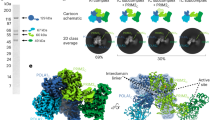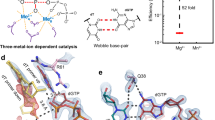Abstract
DNA polymerases catalyze efficient and high-fidelity DNA synthesis. While this reaction favors nucleotide incorporation, polymerases also catalyze a reverse reaction, pyrophosphorolysis, that removes the DNA primer terminus and generates deoxynucleoside triphosphates. Because pyrophosphorolysis can influence polymerase fidelity and sensitivity to chain-terminating nucleosides, we analyzed pyrophosphorolysis with human DNA polymerase β and found the reaction to be inefficient. The lack of a thio-elemental effect indicated that this reaction was limited by a nonchemical step. Use of a pyrophosphate analog, in which the bridging oxygen is replaced with an imido group (PNP), increased the rate of the reverse reaction and displayed a large thio-elemental effect, indicating that chemistry was now rate determining. Time-lapse crystallography with PNP captured structures consistent with a chemical equilibrium favoring the reverse reaction. These results highlight the importance of the bridging atom between the β- and γ-phosphates of the incoming nucleotide in reaction chemistry, enzyme conformational changes, and overall reaction equilibrium.
This is a preview of subscription content, access via your institution
Access options
Access Nature and 54 other Nature Portfolio journals
Get Nature+, our best-value online-access subscription
$29.99 / 30 days
cancel any time
Subscribe to this journal
Receive 12 print issues and online access
$259.00 per year
only $21.58 per issue
Buy this article
- Purchase on Springer Link
- Instant access to full article PDF
Prices may be subject to local taxes which are calculated during checkout





Similar content being viewed by others
References
Bebenek, K. & Kunkel, T.A. Functions of DNA polymerases. Adv. Protein Chem. 69, 137–165 (2004).
Deutscher, M.P. & Kornberg, A. Enzymatic synthesis of deoxyribonucleic acid. 28. The pyrophosphate exchange and pyrophosphorolysis reactions of deoxyribonucleic acid polymerase. J. Biol. Chem. 244, 3019–3028 (1969).
Parsons, J.L., Nicolay, N.H. & Sharma, R.A. Biological and therapeutic relevance of nonreplicative DNA polymerases to cancer. Antioxid. Redox Signal. 18, 851–873 (2013).
McKenna, C.E., Kashemirov, B.A., Peterson, L.W. & Goodman, M.F. Modifications to the dNTP triphosphate moiety: from mechanistic probes for DNA polymerases to antiviral and anti-cancer drug design. Biochim. Biophys. Acta. 1804, 1223–1230 (2010).
Smith, A.J., Meyer, P.R., Asthana, D., Ashman, M.R. & Scott, W.A. Intracellular substrates for the primer-unblocking reaction by human immunodeficiency virus type 1 reverse transcriptase: detection and quantitation in extracts from quiescent- and activated-lymphocyte subpopulations. Antimicrob. Agents Chemother. 49, 1761–1769 (2005).
Urban, S., Urban, S., Fischer, K.P. & Tyrrell, D.L. Efficient pyrophosphorolysis by a hepatitis B virus polymerase may be a primer-unblocking mechanism. Proc. Natl. Acad. Sci. USA 98, 4984–4989 (2001).
Hanes, J.W. & Johnson, K.A. A novel mechanism of selectivity against AZT by the human mitochondrial DNA polymerase. Nucleic Acids Res. 35, 6973–6983 (2007).
Crespan, E., Maga, G. & Hübscher, U. A new proofreading mechanism for lesion bypass by DNA polymerase-λ. EMBO Rep. 13, 68–74 (2011).
Beard, W.A. & Wilson, S.H. Structure and mechanism of DNA polymerase β. Biochemistry 53, 2768–2780 (2014).
Perera, L., Beard, W.A., Pedersen, L.G. & Wilson, S.H. Chapter Four - Applications of quantum mechanical/molecular mechanical methods to the chemical insertion step of DNA and RNA polymerization. Adv. Protein Chem. Struct. Biol. 97, 83–113 (2014).
Freudenthal, B.D., Beard, W.A., Shock, D.D. & Wilson, S.H. Observing a DNA polymerase choose right from wrong. Cell 154, 157–168 (2013).
Kirby, T.W. et al. Metal-induced DNA translocation leads to DNA polymerase conformational activation. Nucleic Acids Res. 40, 2974–2983 (2012).
Das, K. et al. Conformational states of HIV-1 reverse transcriptase for nucleotide incorporation vs pyrophosphorolysis—binding of foscarnet. ACS Chem. Biol. 11, 2158–2164 (2016).
Sawaya, M.R., Prasad, R., Wilson, S.H., Kraut, J. & Pelletier, H. Crystal structures of human DNA polymerase β complexed with gapped and nicked DNA: evidence for an induced fit mechanism. Biochemistry 36, 11205–11215 (1997).
Eckstein, F. Nucleoside phosphorothioates. Annu. Rev. Biochem. 54, 367–402 (1985).
Vande Berg, B.J., Beard, W.A. & Wilson, S.H. DNA structure and aspartate 276 influence nucleotide binding to human DNA polymerase β. Implication for the identity of the rate-limiting conformational change. J. Biol. Chem. 276, 3408–3416 (2001).
Liu, J. & Tsai, M.D. DNA polymerase β: pre-steady-state kinetic analyses of dATP α S stereoselectivity and alteration of the stereoselectivity by various metal ions and by site-directed mutagenesis. Biochemistry 40, 9014–9022 (2001).
Lipton, A. Emerging role of bisphosphonates in the clinic-antitumor activity and prevention of metastasis to bone. Cancer Treat. Rev. 34 (Suppl. 1), S25–S30 (2008).
Rozovskaya, T. et al. Pyrophosphate analogues in pyrophosphorolysis reaction catalyzed by DNA polymerases. FEBS Lett. 247, 289–292 (1989).
Penningroth, S.M., Olehnik, K. & Cheung, A. ATP formation from adenyl-5′-yl imidodiphosphate, a nonhydrolyzable ATP analog. J. Biol. Chem. 255, 9545–9548 (1980).
Oertell, K. et al. Transition state in DNA polymerase β catalysis: rate-limiting chemistry altered by base-pair configuration. Biochemistry 53, 1842–1848 (2014).
Oertell, K. et al. Effect of β,γ-CHF- and β,γ-CHCl-dGTP halogen atom stereochemistry on the transition state of DNA polymerase β. Biochemistry 51, 8491–8501 (2012).
Sucato, C.A. et al. Modifying the β,γ leaving-group bridging oxygen alters nucleotide incorporation efficiency, fidelity, and the catalytic mechanism of DNA polymerase β. Biochemistry 46, 461–471 (2007).
Sucato, C.A. et al. DNA polymerase β fidelity: halomethylene-modified leaving groups in pre-steady-state kinetic analysis reveal differences at the chemical transition state. Biochemistry 47, 870–879 (2008).
Batra, V.K., Beard, W.A., Pedersen, L.C. & Wilson, S.H. Structures of DNA polymerase mispaired DNA termini transitioning to pre-catalytic complexes support an induced-fit fidelity mechanism. Structure 24, 1863–1875 (2016).
Vaisman, A., Ling, H., Woodgate, R. & Yang, W. Fidelity of Dpo4: effect of metal ions, nucleotide selection and pyrophosphorolysis. EMBO J. 24, 2957–2967 (2005).
Li, A., Gong, S. & Johnson, K.A. Rate-limiting pyrophosphate release by HIV reverse transcriptase improves fidelity. J. Biol. Chem. 291, 26554–26565 (2016).
Cruchaga, C., Ansó, E., Rouzaut, A. & Martínez-Irujo, J.J. Selective excision of chain-terminating nucleotides by HIV-1 reverse transcriptase with phosphonoformate as substrate. J. Biol. Chem. 281, 27744–27752 (2006).
Yanvarev, D.V. et al. Methylene bisphosphonates as the inhibitors of HIV RT phosphorolytic activity. Biochimie 127, 153–162 (2016).
Balbo, P.B., Wang, E.C.-W. & Tsai, M.-D. Kinetic mechanism of active site assembly and chemical catalysis of DNA polymerase β. Biochemistry 50, 9865–9875 (2011).
Tsai, Y.-C. & Johnson, K.A. A new paradigm for DNA polymerase specificity. Biochemistry 45, 9675–9687 (2006).
Dahlberg, M.E. & Benkovic, S.J. Kinetic mechanism of DNA polymerase I (Klenow fragment): identification of a second conformational change and evaluation of the internal equilibrium constant. Biochemistry 30, 4835–4843 (1991).
Oertell, K. et al. Kinetic selection vs. free energy of DNA base pairing in control of polymerase fidelity. Proc. Natl. Acad. Sci. USA 113, E2277–E2285 (2016).
Patel, S.S., Wong, I. & Johnson, K.A. Pre-steady-state kinetic analysis of processive DNA replication including complete characterization of an exonuclease-deficient mutant. Biochemistry 30, 511–525 (1991).
Olson, A.C., Patro, J.N., Urban, M. & Kuchta, R.D. The energetic difference between synthesis of correct and incorrect base pairs accounts for highly accurate DNA replication. J. Am. Chem. Soc. 135, 1205–1208 (2013).
Perera, L. et al. Requirement for transient metal ions revealed through computational analysis for DNA polymerase going in reverse. Proc. Natl. Acad. Sci. USA 112, E5228–E5236 (2015).
Yount, R.G. Adenylylimidodiphosphate and guanylylimidodiphosphate. Methods Enzymol. 38, 420–427 (1974).
Johnson, K.A. Conformational coupling in DNA polymerase fidelity. Annu. Rev. Biochem. 62, 685–713 (1993).
Kadina, A.P. et al. Two scaffolds from two flips: (α,β)/(β,γ) CH2/NH “Met-Im” Analogues of dTTP. Org. Lett. 17, 2586–2589 (2015).
Nakamura, T., Zhao, Y., Yamagata, Y., Hua, Y.J. & Yang, W. Watching DNA polymerase η make a phosphodiester bond. Nature 487, 196–201 (2012).
Gao, Y. & Yang, W. Capture of a third Mg2+ is essential for catalyzing DNA synthesis. Science 352, 1334–1337 (2016).
Vyas, R., Reed, A.J., Tokarsky, E.J. & Suo, Z. Viewing human DNA polymerase β faithfully and unfaithfully bypass an oxidative lesion by time-dependent crystallography. J. Am. Chem. Soc. 137, 5225–5230 (2015).
Batra, V.K. et al. Magnesium-induced assembly of a complete DNA polymerase catalytic complex. Structure 14, 757–766 (2006).
Beard, W.A. & Wilson, S.H. Purification and domain-mapping of mammalian DNA polymerase β. Methods Enzymol. 262, 98–107 (1995).
Freudenthal, B.D. et al. Uncovering the polymerase-induced cytotoxicity of an oxidized nucleotide. Nature 517, 635–639 (2015).
Beard, W.A., Shock, D.D., Batra, V.K., Prasad, R. & Wilson, S.H. Substrate-induced DNA polymerase β activation. J. Biol. Chem. 289, 31411–31422 (2014).
Otwinowski, Z. & Minor, W. Processsing of X-ray diffraction data collected in oscillation mode. Methods Enzymol. 276, 307–326 (1997).
Adams, P.D. et al. PHENIX: a comprehensive Python-based system for macromolecular structure solution. Acta Crystallogr. D Biol. Crystallogr. 66, 213–221 (2010).
Emsley, P. & Cowtan, K. Coot: model-building tools for molecular graphics. Acta Crystallogr. D Biol. Crystallogr. 60, 2126–2132 (2004).
Acknowledgements
We thank the Collaborative Crystallography group at NIEHS for help with data collection and analysis. Use of the advanced Photon Source was supported by the US Department of Energy, Office of Science, Office of Basic Energy Sciences, under contract W-31-109-Eng-38. This research was supported by the Intramural Research Program of the NIH, National Institute of Environmental Health Sciences (project numbers Z01-ES050158 and Z01-ES050161) (S.H.W.) and was in association with the National Institutes of Health grant 1U19CA105010 (S.H.W.) and R00-ES024431 (B.D.F.).
Author information
Authors and Affiliations
Contributions
D.D.S., B.D.F., W.A.B., and S.H.W. designed the project. D.D.S. did the kinetic analyses. B.D.F. carried out crystallography. D.D.S., B.D.F., W.A.B., and S.H.W. prepared the manuscript. All authors discussed the results and commented on the manuscript.
Corresponding author
Ethics declarations
Competing interests
The authors declare no competing financial interests.
Supplementary information
Supplementary Text and Figures
Supplementary Results, Supplementary Tables 1–2 and Supplementary Figures 1–8. (PDF 4379 kb)
Rights and permissions
About this article
Cite this article
Shock, D., Freudenthal, B., Beard, W. et al. Modulating the DNA polymerase β reaction equilibrium to dissect the reverse reaction. Nat Chem Biol 13, 1074–1080 (2017). https://doi.org/10.1038/nchembio.2450
Received:
Accepted:
Published:
Issue Date:
DOI: https://doi.org/10.1038/nchembio.2450
This article is cited by
-
Watching right and wrong nucleotide insertion captures hidden polymerase fidelity checkpoints
Nature Communications (2022)
-
Watching a double strand break repair polymerase insert a pro-mutagenic oxidized nucleotide
Nature Communications (2021)
-
Quaternary structural diversity in eukaryotic DNA polymerases: monomeric to multimeric form
Current Genetics (2020)



